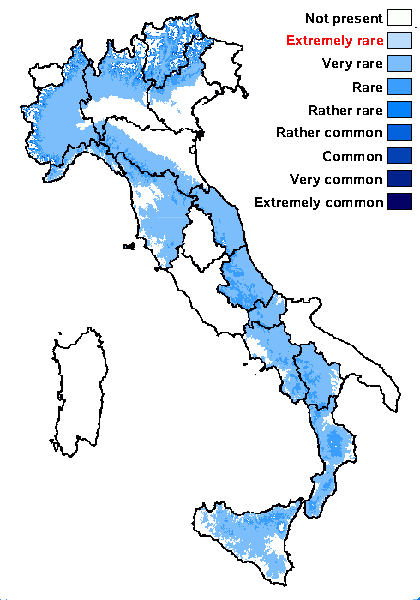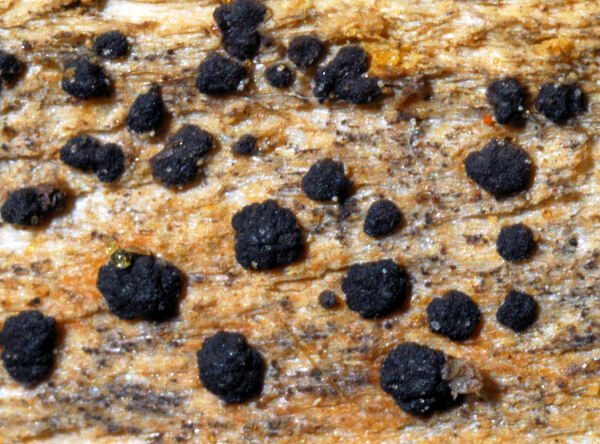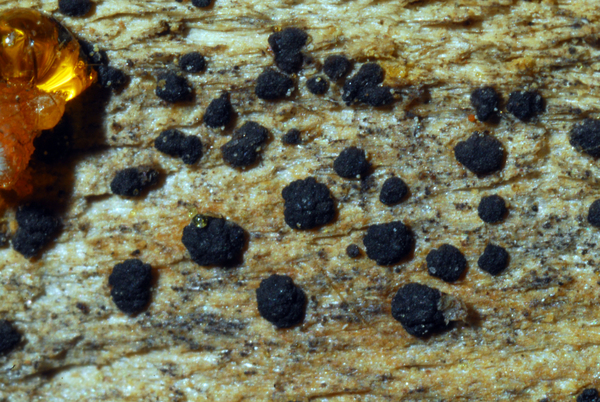Lecidea turgidula Fr.
Sched. Crit., 1: 10, 1824.
Synonyms: Biatora turgidula (Fr.) Nyl.; Lecidea denudata sensu A. Massal.; Lecidea subglomerella Nyl.; Lecidella turgidula (Fr.) Körb.; Oedemocarpus turgidulus (Fr.) Trevis.
Distribution: N - Ven, TAA (Caniglia & al. 2002, Thor & Nascimbene 2007, 2014, Nascimbene & al. 2007b, 2008c, 2022, Nascimbene 2008b, 2013), Lomb, Piem (Isocrono & al. 2004), Emil (Fariselli & al. 2020), Lig (Giordani & al. 2009, Giordani & Incerti 2008). C - Tosc, Marc (Nimis & Tretiach 1999), Abr (Nimis & Tretiach 1999), Mol (Nimis & Tretiach 1999, Caporale & al. 2008). S - Camp (Aprile & al. 2003b), Bas, Cal (Puntillo 1996, van den Boom & Giralt 2002, Puntillo 2011), Si.
Description: Thallus crustose, often poorly developed and inconspicuous, endosubstratic or thinly granular, whitish or olivaceous grey. Apothecia biatorine, black (bluish black when wet), adnate to partly immersed, 0.2-0.6(-0.8) mm across, with an initially flat but soon turning convex, sometimes thinly white-or bluish-pruinose, often uneven disc (especially when young), and a soon excluded proper margin. Proper exciple of coherent, radiating hyphae, dark greenish brown in outer part, colourless within; epithecium olive-black to blue-green, K+ intensifying green, N+ reddish, with minute granules dissolving in K; hymenium with violet, brownish or greenish vertical streaks reacting K+ green, (30-)50-70(-80) µm high, I+ blue; paraphyses sparingly branched and anastomosing, 1-2 µm thick at mid-level, the apical cells not much swollen, but sometimes with a dark brown, to 5 µm wide cap; hypothecium colourless to pale yellowish brown, sometimes orange-brown in upper part. Asci 8-spored, broadly clavate, Bacidia-type. Ascospores 1-celled (rarely a few 1-septate), hyaline, oblong to ellipsoid, 6-10(-14) x 2.5-4.5(-5.5) μm, straight to slightly curved. Pycnidia black, immersed, the wall green-brown, K+ green. Conidia short-bacilliform, arising laterally and terminally, 3-4 x 1.5-1.8 μm. Photobiont chlorococcoid, the cells 12-15 µm wide. Spot tests: thallus K-, C-, KC-, P-, UV-. Chemistry: thallus with placodiolic acid. Note: on hard lignum, more rarely on bark of conifers; most common in the Alps, but also present in the mountains of Southern Italy, especially in old Castanea-woodlands. According to Printzen (1995) the systematic position of this species is not clear; it certainly does not belong to Lecidea s.str.
Growth form: Crustose
Substrata: bark and lignum
Photobiont: green algae other than Trentepohlia
Reproductive strategy: mainly sexual
Commonnes-rarity: (info)
Alpine belt: absent
Subalpine belt: rather common
Oromediterranean belt: absent
Montane belt: rare
Submediterranean belt: very rare
Padanian area: absent
Humid submediterranean belt: very rare
Humid mediterranean belt: absent
Dry mediterranean belt: absent

Predictive model
Herbarium samples


Felix Schumm - CC BY-SA 4.0
[20307], Germany, Harz National Park, Eckertal, slope down to the
east, above confluence of the river "Ecker" into the water dam. On
Picea stub (1 m high). 580 m. Leg. Hans Ullrich, 22.5.1961, det. P.
Czarnota, 28,2,2013.
Growth form: Crustose
Substrata: bark and lignum
Photobiont: green algae other than Trentepohlia
Reproductive strategy: mainly sexual
Commonnes-rarity: (info)
Alpine belt: absent
Subalpine belt: rather common
Oromediterranean belt: absent
Montane belt: rare
Submediterranean belt: very rare
Padanian area: absent
Humid submediterranean belt: very rare
Humid mediterranean belt: absent
Dry mediterranean belt: absent

Predictive model
| Herbarium samples |


 INDEX FUNGORUM
INDEX FUNGORUM
 GBIF
GBIF
 DOLICHENS
DOLICHENS




